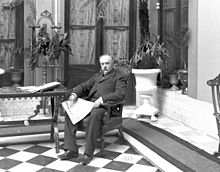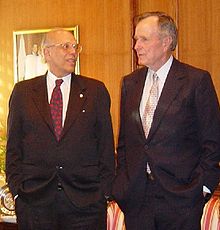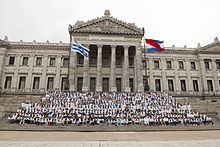Mass immigration and development
After the Guerra Grande, there was a sharp rise in the number of immigrants, primarily from Italy and Spain. By 1879, the total population of the country was over 438,000. The economy saw a steep upswing, above all in livestock raising and exports. Montevideo became a major economic centre of the region and an entrepôt for goods from Argentina, Brazil and Paraguay.20th century
The Colorado leader José Batlle y Ordóñez was elected president in 1903. The following year, the Blancos led a rural revolt and eight bloody months of fighting ensued before their leader, Aparicio Saravia, was killed in battle. Government forces emerged victorious, leading to the end of the co-participation politics that had begun in 1872. Batlle had two terms (1903–07 and 1911–15) during which, taking advantage of the nation's stability and growing economic prosperity, he instituted major reforms such as a welfare program, government participation in many facets of the economy, and a plural executive.
Gabriel Terra became president in March 1931. His inauguration coincided with the effects of the Great Depression., and the social climate became tense as a result of the lack of jobs. There were confrontations in which police and leftists died. In 1933, Terra organized a coup d'état, dissolving the General Assembly and governing by decree. A new constitution was promulgated in 1934, transferring powers to the president. In general, the Terra government weakened or neutralized economic nationalism and social reform.
In 1938, general elections were held and Terra's brother-in-law, General Alfredo Baldomir, was elected president. Under pressure from organized labor and the National Party, Baldomir advocated free elections, freedom of the press, and a new constitution. Although Baldomir declared Uruguay neutral in 1939, British warships and the German ship Admiral Graf Spee fought a battle not far off Uruguay's coast. Admiral Graf Spee took refuge in Montevideo, claiming sanctuary in a neutral port, but was later ordered out. In 1945, Uruguay abandoned its policy of neutrality and joined the Allied cause.
In the late 1950s, partly because of a world-wide decrease in demand for agricultural products, Uruguayans suffered from a steep drop in their standard of living, which led to student militancy and labor unrest. An urban guerrilla movement known as the Tupamaros emerged, engaging in activities such as bank robbery and distributing the proceeds to the poor, in addition to attempting political dialogue. As the government banned their political activities and the police became more oppressive, the Tupamaros took up an overtly armed struggle.
President Jorge Pacheco declared a state of emergency in 1968, followed by a further suspension of civil liberties in 1972. In 1973, amid increasing economic and political turmoil, the armed forces closed the Congress and established a civilian-military regime. Around 180 Uruguayans are known to have been killed during the 12-year military rule of 1973 to 1985. Most were killed in Argentina and other neighbouring countries, with 36 of them having been killed in Uruguay.
Return to democracy (1984–present)
A new constitution, drafted by the military, was rejected in a November 1980 referendum. Following the referendum, the armed forces announced a plan for the return to civilian rule, and national elections were held in 1984. Colorado Party leader Julio María Sanguinetti won the presidency and served from 1985 to 1990. The first Sanguinetti administration implemented economic reforms and consolidated democracy following the country's years under military rule.The National Party's Luis Alberto Lacalle won the 1989 presidential election and amnesty for human rights abusers was endorsed by referendum. Sanguinetti was then re-elected in 1994. Both presidents continued the economic structural reforms initiated after the reinstatement of democracy, and other important reforms were aimed at improving the electoral system, social security, education, and public safety.
The 1999 national elections were held under a new electoral system established by a 1996 constitutional amendment. Colorado Party candidate Jorge Batlle, aided by the support of the National Party, defeated Broad Front candidate Tabaré Vázquez. The formal coalition ended in November 2002 when the Blancos withdrew their ministers from the cabinet, although the Blancos continued to support the Colorados on most issues. Low commodity prices and economic difficulties in Uruguay's main export markets (starting in Brazil with the devaluation of the real, then in Argentina in 2002), caused a severe recession; the economy contracted by 11%, unemployment climbed to 21%, and the percentage of Uruguayans in poverty rose to over 30%.
In 2009, José Mujica, a former left-wing militant who spent almost 15 years in prison during the country's military rule, emerged as the new President as the Broad Front won the election for a second time.
In 2012, abortion was legalized.
In 2013, same-sex marriage and cannabis were legalized.



